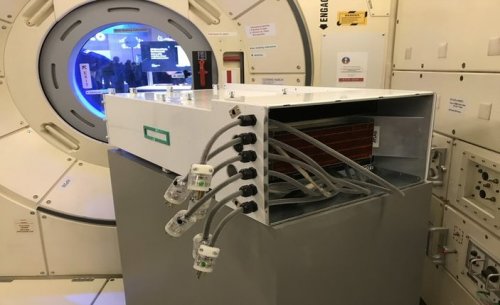SAN FRANCISCO – Hewlett Packard Enterprise announced plans Nov. 1 to offer researchers and astronauts access to its Spaceborne Computer, the supercomputer the Palo Alto, California, company sent to the International Space Station in August 2017.
After a year of testing, HPE has proven its commercial off-the-shelf supercomputer can survive and function reliably in orbit in spite of surprise power outages and fluctuating radiation levels.
“We have now proven to every scientist and engineer we have that capability,” Mark Fernandez, HPE Americas High Performance Computing technology officer, told SpaceNews. “They can shape their experiments based on the knowledge that a miniature data center is there to help.”
It’s unlikely astronauts whose schedules are jam-packed will perform calculations on the Spaceborne Computer anytime soon. Researchers, however, may choose to process data in orbit rather than bringing it back to Earth, Fernandez said.
“Bringing supercomputing capabilities on board the International Space Station will dramatically accelerate data processing and analysis, and in turn, offer new scientific discoveries that drive innovation across various areas,” Dave Hornyak, NASA ISS technology demonstration research portfolio manager, said in a statement. “By giving our astronauts and researchers in space high-level performance, the Spaceborne Computer allows them to convert data into insight more quickly.”
More importantly, HPE has now shown that its supercomputers work in orbit, which means future missions can bring them along.
“If you are headed on a business trip or a vacation, you pack your iPhone or iPad with maps, playlists and videos you might need during your journey,” Fernandez said. The Spaceborne computer can serve a similar purpose for astronauts traveling to Mars or other destinations. “It’s unrelated to spacecraft operations,” Fernandez said. “It can be loaded with the software you need for science, engineering and exploration.”
Astronauts heading to Mars, for example, will be able to access information without waiting up to 24 minutes for radio signals to travel roundtrip. “It will enable space explorers and scientists to be self-sufficient,” Fernandez said.
When HPE sent the Spaceborne Computer into orbit, many information technology experts were skeptical, Fernandez said at the International Space Station Research and Development Conference here in July.
“We took a system from factory floor with no hardening, no preparation, running an open source operating system,” Fernandez said. “The majority of the community didn’t think it would function or wouldn’t last long.”
HPE relied on software to make the computer resilient.
“We monitor power, cooling, components,” Fernandez said. “When they get out of nominal range, we isolate them, work around them or do something. Each system is self-sufficient with fault detection and isolation.”
Similar software could make computers on Earth more resilient, Fernandez said. HPE is exploring seven patents stemming from the Spaceborne Computer experiment.
Fernandez is obviously delighted with the results of the one-year trial because the Spaceborne Computer overcame numerous challenges, “things you cannot plan for or simulate,” Fernandez said.
At one point, an ISS smoke detector suddenly halted power to the Supercomputer.
“Pulling the plug on a Linux server is about the worst thing you can to it,” Ferdandez said. After diagnostics and health checks, however, the “software did what it was supposed to do” and computer kept working.
On another occasion, an astronaut accidently hit a switch that cutoff power to the Spaceborne Computer. “We’ve had it all: unscheduled and scheduled power outages caused by equipment failure and human error,” Fernandez said. “They are completing my experiment.”
NASA officials were surprised how well the Spaceborne Computer worked. “The Spaceborne computer itself had no difficulties from the time it was powered on through the entire one year run,” Hornyak said. “Typically with any new system, there are commissioning and setup adjustments needed, but that wasn’t required with the Spaceborne computer. It powered on at the start, and ran reliably the entire test duration.”
The 56-kilogram Spaceborne Computer fits in an ISS ceiling mounted server rack that is about 30 centimeters by 61 centimeters by 91 centimeters.
- SN Military.Space | Who’s who in the national security space workforce • Doubts raised about cost of Space Force • U.S., Brazil to share space data
- Why Sierra Nevada’s owners are betting big on Dream Chaser
- LEO and MEO broadband constellations mega source of consternation
- SpaceX takes top honors in SpaceNews Awards for Excellence & Innovation
- Space Corps proposal becoming flashpoint in DoD budget negotiations
Share with your friends

(0) Comments
This article comments are currently no :(